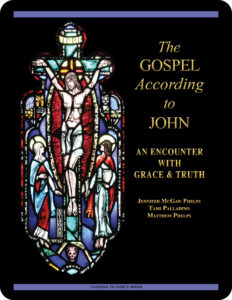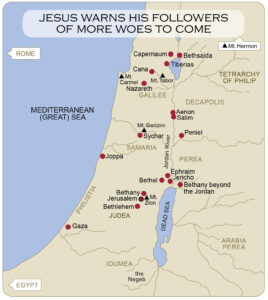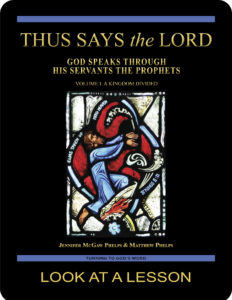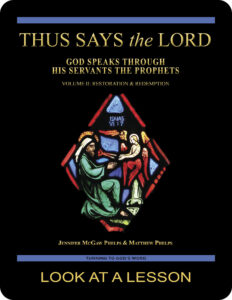 The Gospel According to John:
The Gospel According to John:
An Encounter with Grace & Truth
Lesson 19 When the Spirit of Truth Comes
the Gospel According to John 16:1–33
Revised Standard Version Catholic Edition (RSVCE)*
New American Bible Revised Edition (NABRE)*
Catechism of the Catholic Church
ex libris (in our library)
glossary for the Gospel According to John
cross references in the Gospel According to John
next lesson: And This Is Eternal Life
This material coordinates with Lesson 19 on pages 101–105 in The Gospel According to John: An Encounter with Grace & Truth.
“Now Jesus did many other signs in the presence of the disciples, which are not written in this book; but these are written that you may believe that Jesus is the Christ, the Son of God, and that believing you may have life in his name.”—the Gospel According to John 20:30–31
welcome to our in-depth study of the Gospel According to John
We invite interested groups and individuals to check out the sample first lesson from this 25- lesson Turning to
lesson Turning to  God’s Word Catholic Bible study. These online study pages link to our free lesson videos, as well as to a glossary and cross references in the biblical text. Other study aids include maps, additional commentary, and prayers based on the primary Scripture in each lesson. The Gospel According to John: An Encounter with Grace & Truth has been granted an imprimatur and can be purchased from our website shop. If you have a Bible-study question or comment, click on one of the “ask us your question” or “what do you think” buttons on any online study page.
God’s Word Catholic Bible study. These online study pages link to our free lesson videos, as well as to a glossary and cross references in the biblical text. Other study aids include maps, additional commentary, and prayers based on the primary Scripture in each lesson. The Gospel According to John: An Encounter with Grace & Truth has been granted an imprimatur and can be purchased from our website shop. If you have a Bible-study question or comment, click on one of the “ask us your question” or “what do you think” buttons on any online study page.
open with prayer
It’s always wise to begin any Bible study with prayer, whether reading the Scriptures alone or meeting with others in a discussion study group. You can pray using your own words or use one of the opening prayers on our website. We especially like the following:
Lord Jesus, you promised to send your Holy Spirit
to teach us all things.
As we read and study your word today,
allow it to touch our hearts and change our lives. Amen.
let’s review—the Gospel According to John 15:1–27
In Lesson 18 I Am the True Vine, Jesus uses an agricultural image to continue preparing his disciples for his inevitable departure. All of Jesus’ teaching at this stage of the narrative is directed to explaining his new commandment that people love one another as Jesus has loved us. Toward that end, Jesus describes in more detail what true love looks like. Jesus also repeats his intention to send the Holy Spirit to bear witness to him. In anticipation of the establishment of his Church, Jesus tells the disciples that he expects them also to bear witness to him.
map notes—Jesus isn’t going anywhere
In the sixteenth chapter in the Gospel According to John, Jesus continues what are best referred to as  his farewell discourses. His teaching now is restricted to his disciples, and Jesus has stayed put in one place (in or very near to Jerusalem) for several chapters. In the Fourth Gospel, Jesus shares with his disciples that he knows there’s going to be a positive outcome to all the trials and tribulations he’s about to undergo. The sixteenth chapter ends with Jesus telling his followers all will end well: “I have said this to you, that in me you may have peace. In the world you have tribulation; but be of good cheer, I have overcome the world.” To learn more, read “Be of Good Cheer” on page 103 in The Gospel According to John: An Encounter with Grace & Truth. Click on the image (right) to enlarge the map, which appears on page 104.
his farewell discourses. His teaching now is restricted to his disciples, and Jesus has stayed put in one place (in or very near to Jerusalem) for several chapters. In the Fourth Gospel, Jesus shares with his disciples that he knows there’s going to be a positive outcome to all the trials and tribulations he’s about to undergo. The sixteenth chapter ends with Jesus telling his followers all will end well: “I have said this to you, that in me you may have peace. In the world you have tribulation; but be of good cheer, I have overcome the world.” To learn more, read “Be of Good Cheer” on page 103 in The Gospel According to John: An Encounter with Grace & Truth. Click on the image (right) to enlarge the map, which appears on page 104.
 sin, righteousness & judgment (32:50)
sin, righteousness & judgment (32:50)
In the Gospel According to John 16:8–11, Jesus promises his disciples that when  the Holy Spirit arrives, it will be to convince the world of sin, righteousness, and judgment. In the video for this lesson, Turning to God’s Word author Matthew Phelps discusses why people often skip over this somewhat confusing passage about the purpose of the Holy Spirit in the world. The Greek word that’s translated as convince might be better understood in this context as “persuade” or even as “chastise.” In similar fashion, sin, righteousness, and judgment perhaps can be better understood
the Holy Spirit arrives, it will be to convince the world of sin, righteousness, and judgment. In the video for this lesson, Turning to God’s Word author Matthew Phelps discusses why people often skip over this somewhat confusing passage about the purpose of the Holy Spirit in the world. The Greek word that’s translated as convince might be better understood in this context as “persuade” or even as “chastise.” In similar fashion, sin, righteousness, and judgment perhaps can be better understood  respectively in legal terms of crime, justice, and sentencing. The word Paraclete—or counselor—suggests a legal role for the Holy Spirit, but as a defense attorney and not a prosecutor.
respectively in legal terms of crime, justice, and sentencing. The word Paraclete—or counselor—suggests a legal role for the Holy Spirit, but as a defense attorney and not a prosecutor.
The Scripture ranges for the videos that accompany this Catholic Bible study match the Scripture ranges for the sets of questions in The Gospel According to John: An Encounter with Grace & Truth. You can follow along as Turning to God’s Word author Matthew Phelps discusses Lesson 19, “When the Spirit of Truth Comes,” on pages 101–105 in the study book.
WHAT DO YOU THINK about uncomfortable truths?
In the sixteenth chapter in the Gospel According to John, Jesus starts getting serious about telling his disciples some of the difficult truths he wants them to know about his impending Passion and death. It’s human nature not to want to face bad news. While the difficulties that Jesus is about to face are definitely not going to be pleasant, Jesus has access to more information than the disciples do.
 ? What does Jesus say in this section of the Gospel According to John to indicate that he sees the big picture and knows the ultimate outcome will be positive?
? What does Jesus say in this section of the Gospel According to John to indicate that he sees the big picture and knows the ultimate outcome will be positive?
? What is Jesus telling us about how divine nature differs from human nature when he refers to the Spirit of truth?
? Welcoming the truth is the way that we welcome Jesus into our lives. What uncomfortable truths might the Holy Spirit be telling us today?
? What can men and women do to overcome reluctance in order to welcome uncomfortable truths?
? What benefit might a person receive by being open to the truth?
 inspiration—you could look it up in our archives
inspiration—you could look it up in our archives
The idea of Jesus sending a spirit must have struck the disciples as strange, yet Christians today view inspiration from the Holy Spirit as a very real help. To learn more about the Spirit, read Lost in Translation, an online column in which Turning to God’s Word author Matthew Phelps helps readers connect with ideas expressed in the original languages of the Scriptures. New Lost in Translation entries are posted on Mondays, and past entries are archived on our website. Contact us if you’d like to receive Lost in Translation by email every week.
 the popes inspire us—keeping Jesus’ commandments
the popes inspire us—keeping Jesus’ commandments
To learn more about the work of faith, you can read “Faith Is a Task” on page 104 in The Gospel According to John: An Encounter with Grace & Truth. In it, Pope Benedict XVI reflects on the three dimensions of faith that are manifested through the action of the Holy Spirit as an inner force that harmonizes our hearts with the heart of Jesus.
joy is a Christian characteristic
In the biblical text that accompanies this lesson, Jesus begins talking about rejoicing, saying in the Gospel According to John 16:22: “So you have sorrow now, but I will see you again and your hearts will rejoice, and no one will take your joy away from you.” You can learn more about the value of Christian joy by reading “Sorrow & Joy” on page 105 in The Gospel According to John: An Encounter with Grace & Truth. You also can learn how the Sorrowful and Joyful Mysteries of the Rosary are connected to passages from the Bible in our Turning to God’s Word Catholic Bible study Scripture & the Rosary: New Testament Mysteries, Old Testament Parallels. Free digital lessons from that study rotate on our website throughout the liturgical year. The Joyful Mysteries—Lesson 7 The Angel Gabriel Was Sent to a Virgin through Lesson 11 All Who Heard Him Were Amazed—only are available during the liturgical season of Advent. The Sorrowful Mysteries—Lesson 12 He Began to Be Sorrowful through Lesson 16 There They Crucified Him—only are available during the liturgical season of Lent.
throughout the liturgical year. The Joyful Mysteries—Lesson 7 The Angel Gabriel Was Sent to a Virgin through Lesson 11 All Who Heard Him Were Amazed—only are available during the liturgical season of Advent. The Sorrowful Mysteries—Lesson 12 He Began to Be Sorrowful through Lesson 16 There They Crucified Him—only are available during the liturgical season of Lent.
for additional reflection
In the Gospel According to John 16:33, Jesus issues this statement, which his disciples surely must have found both comforting and challenging at that stage of the narrative: “I have said this to you, that in me you may have peace. In the world you have tribulation; but be of good cheer, I have overcome the world.” The following questions are designed to help readers begin to form their own thoughts and ideas related to the Gospel According to John 16:1–33. For more reflection questions, refer to the introduction to Lesson 19 on page 101 in The Gospel According to John: An Encounter with Grace & Truth.
 ? Putting aside that we know Jesus is on his way to his Passion and accepting that his followers didn’t yet know this, how many ways can you think of in which Jesus’ disciples might have interpreted his statement at the time he made it?
? Putting aside that we know Jesus is on his way to his Passion and accepting that his followers didn’t yet know this, how many ways can you think of in which Jesus’ disciples might have interpreted his statement at the time he made it?
? Consider whether your choices take into account the other things that Jesus has been saying in the sixteenth chapter in the Gospel According to John?
? How does it seem most likely that the majority of the disciples interpreted what Jesus was telling them?
? What part of Jesus’ statement do you find most comforting?
? What part do you find most challenging?
the best Catholic commentary about Scripture
To find out more about how Church teaching is supported by Scripture passages in The Gospel According to John: An Encounter with Grace & Truth, check out the Index of Citations in the Catechism of the Catholic Church. Links (Revised Standard Version Catholic Edition [RSVCE*]) to the primary Scripture passages in the lesson and relevant paragraphs in the Catechism are provided here. Not every passage in the biblical text for this study is referenced in a Catechism paragraph, however.
the Gospel According to John 16:7—paragraph 692
the Gospel According to John 16:7–15—paragraphs 729, 1287
the Gospel According to John 16:8—paragraph 388
the Gospel According to John 16:8–9—paragraph 1433
the Gospel According to John 16:11—paragraph 385
the Gospel According to John 16:13—paragraphs 91, 243, 687, 692, 1117, 2466, 2671
the Gospel According to John 16:13–15—paragraph 2615
the Gospel According to John 16:14—paragraphs 244, 690
the Gospel According to John 16:14–15—paragraph 485
the Gospel According to John 16:23–27—paragraph 2615
the Gospel According to John 16:24—paragraphs 2615, 2815
the Gospel According to John 16:26—paragraph 2815
the Gospel According to John 16:28—paragraph 661, 2795
the Gospel According to John 16:33—paragraph 1808
ways our glossary might prove helpful
In addition to providing extra information about geographical locations, our glossary also points out  persons and places mentioned in the biblical text under multiple names or spellings. If you can remember a name but aren’t sure in which lesson it shows up, you can find it in the glossary, which lists every proper noun that appears in the primary biblical text for The Gospel According to John: An Encounter with Grace & Truth.
persons and places mentioned in the biblical text under multiple names or spellings. If you can remember a name but aren’t sure in which lesson it shows up, you can find it in the glossary, which lists every proper noun that appears in the primary biblical text for The Gospel According to John: An Encounter with Grace & Truth.
to learn more, read more Scripture
If you’re having difficulty with a passage of Scripture, it can be helpful to read the relevant  cross references—but looking these up can take time. To make that easier, we’ve compiled the cross references from the Revised Standard Version Second Catholic Edition (RSV2CE)—the translation that we reprint in our study books. That list can be found at the top of every online study page accompanying this study, and it includes links to each of the cross references in the primary biblical text for The Gospel According to John: An Encounter with Grace & Truth.
cross references—but looking these up can take time. To make that easier, we’ve compiled the cross references from the Revised Standard Version Second Catholic Edition (RSV2CE)—the translation that we reprint in our study books. That list can be found at the top of every online study page accompanying this study, and it includes links to each of the cross references in the primary biblical text for The Gospel According to John: An Encounter with Grace & Truth.
don’t forget about our indexes & extra online material

 If you’re trying to locate information about a specific Scripture passage, you can look it up in the index at the back of the study book or sample lesson. If you want to find a particular commentary, you can look up its title in the topics index. To learn more about another book of the Bible for which there’s a Turning to God’s Word study, visit the online study directories to read the commentaries and watch any accompanying videos. Finally, if you have a question or would like to make a comment about any of our studies, you can use one of the “ask us your question” or “what do you think” buttons to email our authors.
If you’re trying to locate information about a specific Scripture passage, you can look it up in the index at the back of the study book or sample lesson. If you want to find a particular commentary, you can look up its title in the topics index. To learn more about another book of the Bible for which there’s a Turning to God’s Word study, visit the online study directories to read the commentaries and watch any accompanying videos. Finally, if you have a question or would like to make a comment about any of our studies, you can use one of the “ask us your question” or “what do you think” buttons to email our authors.
ex libris—Church documents & books about religious topics
You can find links to magisterial documents referred to in Turning to God’s Word Catholic Bible studies  at ex libris—magisterial documents. This page includes a listing of significant recent encyclicals as well as a number of historical Church documents. Recommended books related to Scripture study can be found at ex libris—main bookshelf.
at ex libris—magisterial documents. This page includes a listing of significant recent encyclicals as well as a number of historical Church documents. Recommended books related to Scripture study can be found at ex libris—main bookshelf.
wondering how to pronounce some of these words?
The following link is to a reading from the New International Version (NIV) Bible. To listen, click on the audio icon above the printed text. Although not taken from the translations used in our study materials, the NIV reading provides an audio guide to pronunciation of words in this lesson’s primary biblical text. A close online version of the translation of the Bible used in Catholic liturgy in the United States as well as an audio guide for daily Mass readings for the current month can be found on the website of the United States Conference of Catholic Bishops (USCCB).
the Gospel According to John 16:1–33 (NIV)
 close with Bible-based prayer related to this lesson
close with Bible-based prayer related to this lesson
Many of our Catholic study groups like to conclude their discussions with a prayer based on the scriptural focus of their lesson, and some participants include Scripture-specific prayer in their individual study. If you’re uncomfortable composing your own Bible-based prayers, you can follow our four easy steps, or you can use the following prayer based on this lesson’s text from the Gospel According to John.
God our Father, your Son promised
to send the Holy Spirit to convince the world
of sin, righteousness, and judgment.
Grant that our hearts and minds
may be open to hear your truth.
We ask this through Jesus Christ, our Lord. Amen.
Lesson 20 And This Is Eternal Life—the Gospel According to John 17:1–26
Lesson 18 I Am the True Vine—the Gospel According to John 15:1–27
you also may like our two-part study of the prophets

 Thus Says the LORD: God Speaks Through His Servants the Prophets—Volume I: A Kingdom Divided examines the prophets in their historical context using the First and Second Books of the Kings and other Old Testament passages written before the Babylonian Exile in 586 B.C. Volume II: Restoration & Redemption looks at the post-exilic prophets. This 51-lesson Catholic Bible study builds on The United Kingdom of Israel: Saul, David & Solomon Foreshadow Christ the King. Click on the books’ covers to view a sample lesson from each volume.start a Turning to God’s Word Bible study
Thus Says the LORD: God Speaks Through His Servants the Prophets—Volume I: A Kingdom Divided examines the prophets in their historical context using the First and Second Books of the Kings and other Old Testament passages written before the Babylonian Exile in 586 B.C. Volume II: Restoration & Redemption looks at the post-exilic prophets. This 51-lesson Catholic Bible study builds on The United Kingdom of Israel: Saul, David & Solomon Foreshadow Christ the King. Click on the books’ covers to view a sample lesson from each volume.start a Turning to God’s Word Bible study
 Thank you for your interest in The Gospel According to John: An Encounter with Grace & Truth.
Thank you for your interest in The Gospel According to John: An Encounter with Grace & Truth.  Information about beginning a Turning to God’s Word Bible study can be found at start a Bible study. Tami, Matthew, and I are available to answer questions and offer support. Contact us if you’d like to start one of our studies or have your schedule listed with other TtGW study groups on our website. —Jennifer
Information about beginning a Turning to God’s Word Bible study can be found at start a Bible study. Tami, Matthew, and I are available to answer questions and offer support. Contact us if you’d like to start one of our studies or have your schedule listed with other TtGW study groups on our website. —Jennifer
*There are seven deuterocanonical books in the Old Testament—the Books of Tobit, Judith, Wisdom, Sirach, Baruch, and First and Second Maccabees, as well as some passages in the Books of Esther and Daniel. Protestants usually refer to these works as “apocryphal,” a word that means “outside the (Protestant) canon” because they’re excluded from most Protestant Bibles. The word “deuterocanonical” means “second canon”; Catholics use that word to refer to any section of the Catholic Old Testament for which there are no extant, or existing, Hebrew manuscripts. All of the deuterocanonical books appear in the Septuagint, the earliest remaining versions of which date to the 1st century B.C. This Greek translation of the Old Testament was in common use by Jews at the time of Jesus—but the same books aren’t found in existing Hebrew manuscripts, which aren’t as old as the oldest version of the Septuagint. Learn more by reading How Do Catholic & Protestant Bibles Differ?
Turning to God’s Word printed Bible studies use the 2006 Revised Standard Version Second Catholic Edition (RSV2CE) translation for all Scripture references except those to the Psalms, which are taken from The Abbey Psalms and Canticles, prepared by the Benedictine monks of Conception Abbey and published in 2020 by the United States Conference of Catholic Bishops (USCCB). All Scripture links for the online study pages for The Gospel According to John: An Encounter with Grace & Truth are to the 1966 Revised Standard Version Catholic Edition (RSVCE) translation. The New International Version (NIV) audio recordings follow the same chapter and verse numbering as the RSV Catholic translations, but the NIV translation doesn’t include the deuterocanonical books and passages.
The 1966 RSVCE uses archaic pronouns and verb forms such as “thee,” “thou,” “didst” in the Psalms and in direct quotations attributed to God. The 2006 RSV2CE replaces those with more accessible English. The few significant translation changes in the RSV2CE include rendering almah as “virgin” in the Book of Isaiah 7:14 and restoring the term “begotten” in the Gospel According to John 3:16.
Numbering varies for some passages in this Bible study. Turning to God’s Word studies (print and digital) follow the numbering in the Revised Standard Version Catholic translations (RSV2CE and RSVCE). Discrepancies in the New American Bible Revised Edition (NABRE) are noted in the Index of Scripture Citations in the study book and the online sample.
 You can learn more about the Psalms by viewing a sample lesson from the Turning to God’s Word Catholic Bible study Sing a New Psalm: Communicating with God Through the Prayers of the Church—Volume I: Lauds & Vespers. The second part of that study, Sing a New Psalm: Communicating with God Through the Prayers of the Church—Volume II: Vigils, Day Prayer & Compline, is scheduled for publication in 2025. Some verse numbers may vary in different translations of the Psalms.
You can learn more about the Psalms by viewing a sample lesson from the Turning to God’s Word Catholic Bible study Sing a New Psalm: Communicating with God Through the Prayers of the Church—Volume I: Lauds & Vespers. The second part of that study, Sing a New Psalm: Communicating with God Through the Prayers of the Church—Volume II: Vigils, Day Prayer & Compline, is scheduled for publication in 2025. Some verse numbers may vary in different translations of the Psalms.
